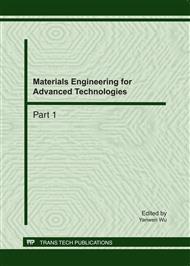p.443
p.448
p.453
p.459
p.466
p.472
p.478
p.484
p.490
80°С-Based TD-GC/MS Analysis of Chemical Components from Branches of Cinnamomum camphora
Abstract:
The analytical result by 80°С-based TD-GC/MS showed that 65 peaks were obtained from the helium volatiles from the fresh branches of Cinnamomum camphora and 60 chemical compounds were identified. The results showed that the main components were as: 1,3-Benzodioxole, 5-(2-propenyl)- (12.629%), Tricyclo[2.2.1.0(2,6)]heptane, 1,7-dimethyl-7-(4-methyl-3-pentenyl)-, (-)- (10.302%), 3-Cyclohexene-1-methanol, .alpha.,.alpha.4-trimethyl- (9.084%), Bicyclo[2.2.1] heptan-2-one, 1,7,7-trimethyl-, (1R)- (7.406%), Nerolidol (6.695%), Bicyclo[2.2.1]heptane, 2-methyl-3-methylene-2-(4-methyl-3-pentenyl)-, (1S-exo)- (6.017%), Bicyclo[2.2.1]heptan-2-one, 1,7,7-trimethyl-, (.+/-.)- (4.885%), Bicyclo[3.1.1]hept-2-ene, 2,6-dimethyl-6-(4-methyl-3-pentenyl)- (4.680%), Naphthalene, 1,2,3,5,6,8a-hexahydro-4,7-dimethyl-1-(1-methylethyl)-, (1S-cis)- (4.139%), 3-Cyclohexen-1-ol, 4-methyl-1-(1-methylethyl)-, (R)- (3.538%), Copaene (2.749%), Bicyclo[2.2.1] heptan-2-ol, 1,7,7-trimethyl-, (1S-endo)- (2.643%), Acetic acid, 1,7,7-trimethyl-bicyclo [2.2.1]hept-2-yl ester (2.536%), Cyclohexane, bromo- (2.530%), 1,6,10-Dodecatriene, 7,11- dimethyl-3-methylene-, (E)- (1.725%), Naphthalene, 1,2,3,4,4a,5,6,8a-octahydro-7-methyl-4- methylene-1-(1-methylethyl)-, (1.alpha.,4a.beta.,8a.alpha.)- (1.265%), Bicyclo[4.4.0]dec-1-ene, 2-isopropyl-5-methyl-9-methylene- (1.174%), (-)-Isosativene (1.149%), 11-Tetradecen-1-ol acetate (1.118%), .alpha.-Cadinol (1.061%), etc. The analytical result suggested that the helium volatiles from the fresh branches of C. camphora could be used as industrial materials of biomedicines, spicery and food industry.
Info:
Periodical:
Pages:
466-471
Citation:
Online since:
June 2011
Authors:
Price:
Сopyright:
© 2011 Trans Tech Publications Ltd. All Rights Reserved
Share:
Citation:


